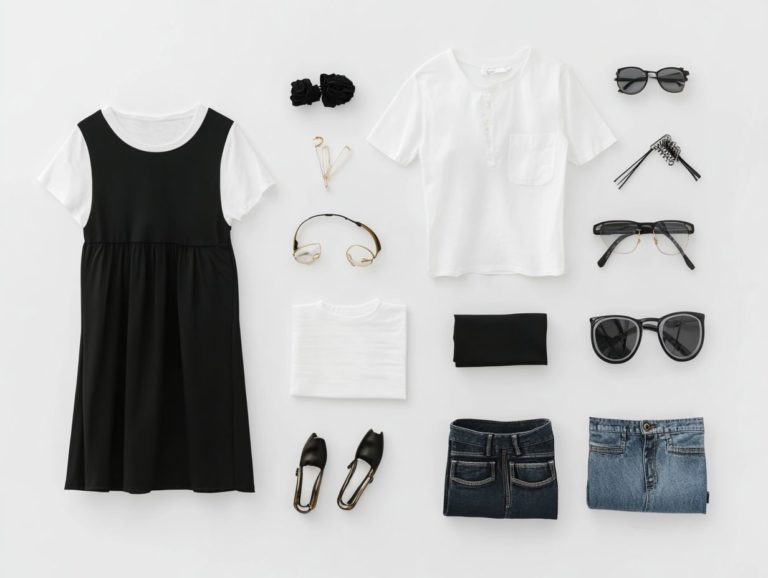How to Reduce Your Wardrobe’s Environmental Impact
The fashion industry is a significant contributor to environmental destruction. Its impacts stem from production processes that use a lot of resources and wasteful consumer habits. Understanding how clothing choices affect the environment is the first step toward making a positive difference in sustainable fashion.
We will explore practical ways to reduce your wardrobe’s consumption and ecological footprint, such as:
- Opting for alternatives to fast fashion, like clothing rental services.
- Purchasing secondhand items from thrift stores.
- Selecting sustainable materials like organic cotton and recycled polyester.
We will also share tips on how to care for, repair, and recycle clothing. Highlighting these practices shows how individual choices can foster positive change for the planet.
Contents
- Key Takeaways:
- The Environmental Impact of Clothing
- Ways to Reduce Your Wardrobe’s Impact
- Practical Tips for Sustainable Wardrobe Management
- How Your Choices Shape the Fashion Future
- Frequently Asked Questions
- How can I reduce my wardrobe’s environmental impact?
- What are sustainable fashion brands?
- How can I repurpose old clothing?
- Why is washing clothes in cold water more environmentally friendly?
- Is it better to buy new or used clothing?
- What other small changes can I make to reduce my wardrobe’s environmental impact?
Key Takeaways:
- Always opt for sustainable materials, such as organic cotton, bamboo clothing, or recycled polyester, when shopping to reduce your wardrobe’s environmental impact.
- Extend the life of your high-quality garments by practicing proper care and maintenance, repairing items when needed, and donating or recycling them when you no longer need them.
- Make informed choices to support sustainable brands by opting for fast fashion alternatives, such as buying secondhand and participating in clothing swaps.
The Environmental Impact of Clothing
The environmental impact of clothing extends well beyond the fabric itself. The fashion industry significantly contributes to climate change, pollution, and waste. This is primarily due to fast fashion, which is clothing made quickly and sold cheaply, harming the environment.
This approach has led to a substantial carbon footprint and significant waste. It’s crucial to embrace sustainable fashion principles and utilize eco-friendly materials, like organic cotton, bamboo clothing, and recycled polyester.
Understanding the Issue
Understanding the environmental impact of clothing is essential to combat the challenges posed by fast fashion and its unsustainable practices. The dangers of fast fashion are becoming increasingly evident as consumers seek cheaper clothing options while ignoring sustainable choices.
Pollution from textile production occurs when dyes and toxic chemicals are released into water systems, contaminating aquatic ecosystems and drinking water sources. The enormous amount of water required for manufacturing worsens global water shortages, forcing communities in drought-stricken areas to rely on contaminated water, which increases the demand for eco-friendly laundry detergent.
The accumulation of discarded clothing in landfills worsens the growing waste crisis. Synthetic fibers can take decades to decompose naturally. Therefore, raising awareness about clothing’s environmental impact is vital for helping individuals make informed decisions and promoting the movement toward sustainable clothing practices, including clothing donations and thrift store support.
Ways to Reduce Your Wardrobe’s Impact
The environmental impact of a wardrobe can be minimized by embracing responsible consumption, purchasing sustainable fashion, and supporting ethical brands and local designers that use eco-friendly materials and produce high-quality products.
Start making eco-friendly clothing choices today for a greener tomorrow!
Fast Fashion Alternatives
Alternatives to fast fashion include clothing rental services, repurposing old clothes into new, unique items, shopping from ethical brands, and investing in timeless pieces. These choices are essential for a sustainable wardrobe designed to last beyond a single season. They promote sustainable fashion by reducing over-consumption and waste associated with the fast fashion industry.
- Clothing Rental Services: For those who wish to stay in style without the waste of fast fashion items, renting clothing offers a practical solution.
- Repurposing Old Clothes: Individuals can breathe new life into old garments through repurposing, creating unique pieces while keeping clothing out of landfills and minimizing the demand for fast fashion production.
- Shopping Ethical Brands: Exploring ethical brands that prioritize environmentally friendly materials and fair labor practices allows consumers to make responsible fashion choices.
- Investing in Timeless Pieces: Investing in timeless garments encourages thoughtful purchasing and helps build a wardrobe that remains stylish over time, reducing the temptation to frequently buy fast fashion items.
Buying Secondhand
Secondhand clothing is a sustainable fashion choice that reduces waste and promotes a circular economy, a system where products are reused, reducing waste. Thrift stores, secondhand shops, and vintage clothing shops are excellent options for eco-conscious consumers. By purchasing secondhand items, individuals contribute to decreasing textile waste, which the U.S. Environmental Protection Agency (EPA) identifies as the second-fastest growing environmentally harmful waste material in the world.
Supporting local thrift shops and local designers is crucial. These stores often depend on their local communities for survival. Reducing textile waste has a positive environmental impact, and discovering unique vintage clothing and participating in clothing swaps can offer a fun and rewarding experience.
Each piece carries its own history, character, and story, transforming the shopping experience into a treasure hunt rather than a chore. This allows consumers to express their creative fashion choices while supporting and invigorating the local economy, fostering a more sustainable and responsible fashion industry.
Choosing Sustainable Materials
Using sustainable materials like organic cotton, bamboo, and recycled polyester is crucial for a greener fashion industry. These alternatives help reduce dependence on petroleum-derived synthetic fibers, such as polyester, while significantly decreasing water consumption and chemical runoff associated with traditional textile production.
By opting for natural fibers, consumers contribute to healthier ecosystems. These products are biodegradable and have a smaller environmental footprint. Shoppers can make informed choices by seeking out brands with transparent sourcing processes, thus supporting manufacturers committed to promoting sustainable practices.
This conscious decision can help steer the market toward a more sustainable and environmentally friendly future, benefiting both the planet and generations to come. Encourage the use of reusable bags and sustainable practices in daily life.
Practical Tips for Sustainable Wardrobe Management
Best practices for managing a sustainable wardrobe encompass tips for clothing care, maintenance techniques, and the use of eco-friendly materials, including eco-friendly laundry detergent. These practices are designed to prolong the life of garments while promoting sustainability.
Start your sustainable journey today by exploring your local thrift shop!
Clothing Care and Maintenance
Proper clothing care and maintenance are essential for creating a sustainable wardrobe and reducing the environmental impact of fashion consumption. Eco-friendly laundry practices, like using eco-friendly laundry detergent, can significantly lower an individual’s carbon footprint while extending the lifespan of their garments.
Washing clothes in cold water with biodegradable detergents—which break down naturally and do not harm the environment—helps protect delicate fabrics and conserves energy. Air drying instead of using a dryer maintains clothing integrity and saves energy, reinforcing the value of sustainable practices.
Employing proper storage techniques, such as using breathable garment bags and avoiding overstuffed closets, further preserves the quality of clothing. These practices promote a more sustainable lifestyle and ensure that each piece remains a staple in the wardrobe for many years to come.
Encouraging consumers to embrace clothing rental services and creative fashion choices is crucial for sustainability.
Repair and Reuse
Repairing clothes and reusing high-quality garments, along with participating in clothing swaps, significantly reduces textile waste and extends the lifespan of clothing. Mending small holes, fixing frayed hems, or replacing buttons saves money. It also helps the environment.
Engaging in DIY repairs and donating clothing that can’t be fixed adds a personalized touch, giving garments unique character while minimizing one’s carbon footprint. Certain damages may require professional expertise, such as intricate fabric repairs or tailoring, to ensure that garments look their best.
Embracing this approach fosters creativity and skill development, encouraging a mindset that prioritizes resourcefulness and creating a ripple effect in sustainable consumption.
Donating and Recycling
Donating and recycling clothing are two of the most effective ways to promote sustainable fashion and reduce landfill waste, granting a second life to garments while benefiting local communities. By choosing to donate clothing, individuals can give their gently used items a new purpose, making them accessible to others in need. Local charities, thrift stores, and shelters can provide affordable clothing options to the community, fostering a sense of responsibility and sustainability.
Recycling textiles through dedicated programs not only helps eliminate harmful waste but also conserves resources and energy, significantly reducing environmental impact. These initiatives foster a sense of responsibility and community engagement, encouraging residents to participate in creating a cleaner and greener future.
When we support textile recycling programs, we create a cleaner future together and join the fight against climate change! By collectively uplifting our communities through clothing rental services and secondhand shopping, we contribute to the interconnectedness of local actions and global environmental well-being.
How Your Choices Shape the Fashion Future
Consumer choices play a vital role in shaping the future of the fashion industry. The shift toward sustainable fashion and ethical brands significantly reduces the environmental impact of clothing consumption.
How Your Choices Can Make a Difference
Consumer choice is crucial in the ability of sustainable fashion to mitigate the negative environmental impacts of clothing production. By supporting brands that embrace ethical practices, individuals not only reduce waste but also encourage other brands to adopt eco-friendly practices.
Many consumers might not realize the extent of their influence in raising industry standards for transparency regarding the sourcing and manufacturing of products. Opting for labels committed to sustainable production sends a clear message that a shift is necessary.
This type of consumer choice helps cultivate a community that values ethical considerations as highly as aesthetic ones, influencing future innovations in sustainable practices.
Start today by choosing brands that prioritize the planet!
Frequently Asked Questions
How can I reduce my wardrobe’s environmental impact?
Reducing your wardrobe’s environmental impact is easy with small changes in your shopping and clothing care habits. Shop for sustainable and ethical fashion brands. Repurpose old clothing and wash your clothes in cold water.
What are sustainable fashion brands?
Sustainable fashion brands focus on eco-friendly and ethical practices in production. They often use organic or recycled materials, support fair labor, and work to reduce carbon emissions.
How can I repurpose old clothing?
There are many fun ways to repurpose old clothing. Turn t-shirts into reusable bags or create a unique denim jacket from old jeans. You can also donate gently used clothing to thrift stores or participate in clothing swaps.
Why is washing clothes in cold water more environmentally friendly?
Washing clothes in cold water saves energy since heating water consumes a lot of household energy. It also helps keep your clothes’ color and quality intact, extending their lifespan and reducing the need for replacements.
Is it better to buy new or used clothing?
Buying used clothing is generally more sustainable than purchasing new. Each secondhand purchase saves resources and keeps clothing out of landfills. This choice significantly lessens your environmental impact.
What other small changes can I make to reduce my wardrobe’s environmental impact?
Along with shopping sustainably and repurposing clothing, try mending your clothes. You can also opt for natural and biodegradable laundry detergents. Finally, recycle or properly dispose of clothing that can no longer be used.




